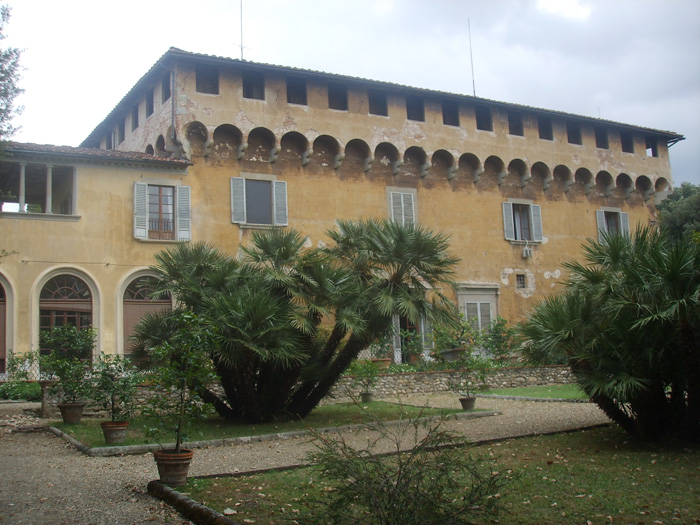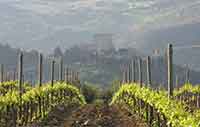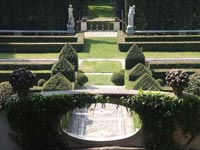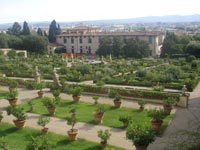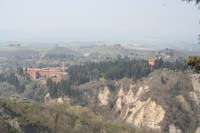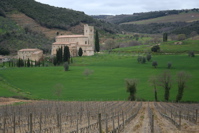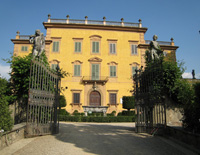| |
|
| |
|
|
|
|
|
|
| |
 |
 |
| Villa Medici at Careggi, the Villa Carreggi, a short distance from Florence on the road to Fiesole
|
|
 |
|
| |
|
|
|
| |
|
|
|
|
| |
|
The Villa Medici at Careggi is a patrician villa in the hills near Florence in Tuscany. The garden nestles behind a high wall and is famed as the place where Cosimo de' Medici (1389-1464) assembled his Platonic academy.
The Gardens, have undergone several radical changes over the years, including one in the nineteenth century. The gardens of the Villa at Careggi were already important in the day of Lorenzo the Magnificent and therefore were designed in accordance with ideals that can be traced to antiquity. Unfortunately, not a trace remains of the original layout because the gardens, like the villa, had been redesigned several times.
Bought by the Medici family in 1417, the villa was inherited following the death of Giovanni di Bicci dei Medici by his son Cosimo the Elder, who commissioned Michelozzo to renovate the property. A great deal of work was done, the focus of attention being the characteristically trapezoid court, with loggias. Michelozzo also created the loggias on the upper floors, opening the building up to the garden and the surrounding countryside.
The villa was among the first [1] of a number of Medici villas, notable as the site of the Platonic academy founded by Cosimo de' Medici, who died at the villa in 1464. Like most villas of Florentine families, the villa remained a working farm that helped render the family self-sufficient. Cosimo's architect there, as elsewhere, was Michelozzo, who remodelled the fortified villa which had something of the character of a castello. Its famous garden is walled about, like a medieval garden, overlooked by the upper-storey loggias, with which Michelozzo cautiously opened up the villa's structure. Michelozzo's Villa Medici in Fiesole has a more outward-looking, Renaissance character.
|
|
|
|
| |
|
|
|
|
|
Villa Medici at Careggi
|
| The property was purchased in 1417. At the death of Giovanni di Bicci, Cosimo il Vecchio set about remodelling the beloved villa around its loggia-enclosed central courtyard. When Cosimo the Elder died, at Careggi itself in 1464, and his son followed him to the grave just five years later, the nephew Lorenzo il Magnifico became the head of the Medici family. It was to this villa that Lorenzo brought his friends, members of the Plato Academy, and here that he spent the last years of his life, until his own death in 1492. Surviving descriptions of the garden as it was in the time of Lorenzo speak of vegetation composed of myrtles, olives, oaks, poplars, pines, plane trees, citrus trees and such exotic spices as frankincense and myrrh. The description suggests that the garden was in two parts, one for the cultivation of flowers and fruit and another "wilder" part. After Lorenzo il Magnifico's death, the villa gradually began to fall into a state of disrepair, a decline that was halted by cardinal Carlo who, after 1615, undertook extensive projects to transform the interior and the garden. Having passed into the hands of the Lorraine household, when they came to power in the Grand-Duchy following the demise of the Medici dynasty, the property was bought in 1779 by Vincenzo Orsi. The Orsi family in turn sold the estate to English geologist and natural history scholar Francis Sloane, in 1848. It was Sloane who transformed the garden into a "romantic" park, introducing many exotic trees, many of which still stand (Lebanon and Himalayan cedars, Californian sequoias, Greek arbutus (or Greek Strawberry Tree) and palms)[2], and constructed an orangery with a valuable collection of citrus fruits and many varieties of palm tree. After Sloane's death the property changed hands several times, and was eventually bought by a hospital, the Arcispedale di Santa Maria Nuova, in 1936.
|
|
|
|
|
 |
Villa Medici at Careggi |
|
|
|
 |
Villa Medici at Careggi, The asymmetrical courtyard by Michelozzo
|
Art in Villa Medici at Careggi
|
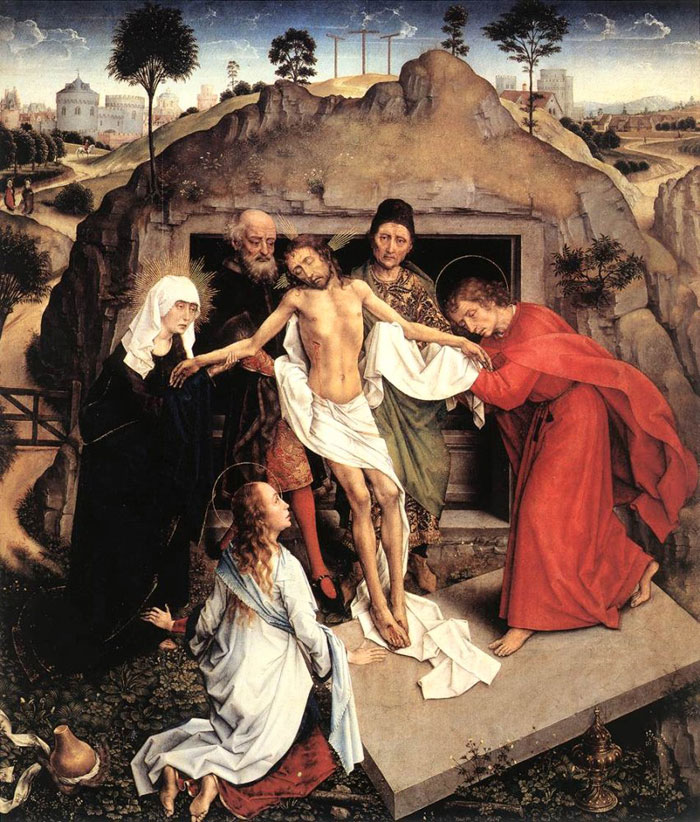 |
Rogier van der Weyden, 1460-1463, Entombment of Christ, Uffizi, Florence
|
|
The Medici inventory of 1492 records the Entombment of Christ hanging in the Medici villa in Careggi, which was built by Cosimo de'Medici. The figure of Nicodemus, dressed in expensive clothing and gazing out towards the spectator, has been identified as a portrait of Cosimo.
Cosimo also owned Rogier's small panel of the Virgin with the Child and Four Saints, painted in 1450, the year Rogier visited Italy, though there is no direct evidence that Rogier ever visited Florence.
The work follows the Entombment of Christ from the predella of Fra Angelico's San Marco Altarpiece, painted around 1440. Fra Angelico's influence is evident in the display of the dead man, shown almost standing, with Mary and John holding his arms one on each side, and more particularly in the hill with the tomb in the rock, unusual in Flemish art.
The San Marco altarpiece was itself an important piece of Medici patronage.
|
|
|
| |
|
|
Villa Medici at Careggi | Opening hours: Mondays to Fridays from 9am to 6pm, visitors are preferred during the afternoon; Saturdays from 9am to 12pm; closed Sundays and holidays; individual visitors will be granted immediate access, while reservations are necessary for groups (tel. 055/4279496 or 055/4279497).
Admission: free

Gardens in Tuscany | Fiesole churches and villas
Fiesole was independent for several centuries in the early Middle Ages, and it almost held the same power that Florence did. However, many wars arose between Florence and Fiesole, and in 1010 and 1025 Fiesole was ransacked by Florentine’s. Fiesole was then conquered by Florence in 1125, and its leading families began to form residences in Florence as well. By the 14th century, wealthy Florentine families had villas in Fiesole.
Amanda Lillie , Florentine villas in the fifteenth century: an architectural and social history, Cambridge University Press, 2005
In this book, which was originally published in 2005, Amanda Lillie challenges the urban bias in Renaissance art and architectural history by investigating the architecture and patronage strategies, particularly those of the Strozzi and the Sassetti clans, in the Florentine countryside during the fifteenth century. Based entirely on archival material that remained unpublished at the time of publication, her book examines a number of villas from this period and reconstructs the value systems that emerge from these sources, which defy the traditional, idealized interpretation of the 'renaissance villa'. Here, the house is studied in relation to the families who lived in them and to the land that surrounded them. The villa emerges as a functional, utilitarian farming unit upon whose success families depended, and where dynastic and patrimonial values could be nurtured.
This page uses material from the Wikipedia article Villa medicea di Careggi, published under the GNU Free Documentation License.
Wikimedia Commons has media related to Villa medicea di Careggi.

|
[1] The Villa Medicea di Cafaggiolo and the Villa Medicea del Trebbio in the valley of the Mugello had been previous purchases.
[2] Arbutus andrachne, commonly called the Greek Strawberry Tree, is an evergreen shrub or small tree in the family Ericaceae, native to the Mediterranean region, the Middle East, and southwestern Asia.
The Greek Strawberry Tree is an evergreen shrub or small tree with gray-brown bark that flakes back to reveal the reddish brown bark underneath. Strawberry tree is native to Greece, Turkey and Lebanon. Containing a high salt tolerance, strawberry tree is an excellent choice for gardens in coastal Mediterranean climates. The plant is a late bloomer, producing flowers and globular orange red fruits in autumn.
Strawberry Tree Honey is considered a very rare honey due to difficulty in production during autumn months, and for its peculiar gustatory characteristics. With a remarkable aroma, you are reminded of forest ivy leaves and fresh coffee grounds. Sweet and pleasantly tasting at first, pungent and decidedly bitter in flavor later. Strawberry Tree Honey accompanies well seasoned and persistent cheeses, sliced cold cooked and cured meats, and unusual pairings include unsalted soft and creamy cheeses. Folklore has it that this honey has good anti-asthmatic attributes.
The strawberry tree was regarded as sacred to Hermes, for he was said to have been nursed beneath the boughs of such a tree.
|
|

The Greek Strawberry Tree |


Podere Santa Pia, a formal cloister in the Tuscan Maremma with a view made in heaven is the perfect holiday resort for relaxing and enjoying the splendor of the Maremma hills of southern Tuscany. Podere Santa Pia enjoys a wonderful panoramic view of the Tuscan Maremma and is located near many cultural and historical places of interest and is close to the Tuscan Maremma coast, places as Massa Marittima, Castiglione della Pescaia, Marina di Grosseto, Principina a Mare, Punta Ala.
Artist and writer's residency | Holiday houses in Tuscany | Podere Santa Pia
|
|
|
|
|
|
|
|
|
|
|
| Wine regions |
|
Podere Santa Pia |
|
Podere Santa Pia, view from the garden
on the valley below
|
| |
|
|
|
|
|
|
|
|
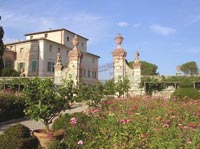
|
Villa I Tatti |
|
Parco di Villa Reale di Castello (Villa di Castello) in Florence |
|
|
|
|
|
|
|
Monte Oliveto Maggiore abbey |
|
Abbey of Sant 'Antimo |
|
Villa La Pietra, near Florence |
| |
|
|
|
|
Villa Medicea di Cafaggiolo
During the 15th and 16th centuries, the Tuscan aristocracy, who had forsaken their medieval castles for the political expediency, comfort and greater security of town life, developed an aesthetic awareness which necessitated the seasonal occupation of a country retreat. The new humanist values they sought could be found in an attractive country setting, enhanced by a garden. The first of these villas were built by the Medici family, whose affluence coincided with the beginning of the Renaissance period, circa 1420. The builder of Villa Medicea di Cafaggiolo was Cosimo de' Medici, whose villa at Careggi is considered to be the model for the Renaissance villas of Florence. These early villas as in the case at both Careggi and Villa Medicea di Cafaggiolo were the result of the complete rebuilding of existing Medici castles.
The Villa Medicea di Cafaggiolo is a villa situated near the Tuscan town of Barberino di Mugello in the valley of the River Sieve, some 25 kilometres north of Florence, central Italy. It was one of the oldest and most favoured of the Medici family estates, having been in the possession of the family since the 14th century, when it was owned by Averardo de' Medici.[1] Averardo's son, Giovanni di Bicci de' Medici, is considered to be the founder of the Medici dynasty.
The villa was reconstructed following designs of the eminent Renaissance architect Michelozzo in 1452, becoming a meeting place for some of the greatest intellectuals of the Italian Renaissance. The villa is located in the Mugello region, the area which was the homeland of the Medici. Although by no means the grandest or largest of their many houses, they visited it often: as a consequence, the villa was the scene of many momentous events in the history of the dynasty, ranging from the reception of Medici brides to the murder of a Medici wife.
Fiesole
The history of the Florence region as a whole is barely distinguishable from that of Florence itself, which was founded in 59 B.C. before it was actually built some twenty years later, or from that of the even more ancient city of Fiesole.
Although this city was originally a major Etruscan township which the Romans had colonised in 80 B.C., a wealth of ancient finds from the 15th and 14th centuries B.C. (Middle Bronze Age) exhibited in the Archaeological Museum bear testimony to an even more distant past. Considerable parts of the 3rd century B.C. city walls are still largely intact, as is the large Roman theatre which was probably completed just before the middle of the 1st century A.D. Fiesole also pre-dates Florence as a seat of bishops. Its early 11th-century cathedral and 13th-century bell tower overlook the large square named after the famous Renaissance sculptor Mino da Fiesole.
The Bishop's Palace (Palazzo Vescovile) situated right opposite the cathedral dates back to the same period, but was rebuilt in the 17th century.
The nearby Seminario building was constructed at the close of the same century, as was the road which climbs up as far as the seat of the ancient Etruscan acropolis, San Francesco. It was there that Franciscan friars built a convent in the 14th century and began to put together what today is one of the most important collections of Chinese bronzes extant in Italy (Museo Missionario).
On the opposite side of the square, facing the Seminario, are the Town Hall (Palazzo Comunale) and a church (chiesa di Santa Maria Primerana). The Museo Bandini houses a valuable collection of paintings and sculptures (10th-18th centuries), while 19th century documents and works of art are preserved on the premises of the Fondazione Primo Conti.
Among the countless prestigious ancient residences belonging to the main Florence noble families which are dotted around the outskirts of the city, particular mention should be made of the Villa Medici, which was built by Michelozzo at the instigation of Cosimo the Elder in 1458.
Halfway along the road from Fiesole to Florence is the 15th century monastery of San Domenico, where Friar Beato Angelico lived and worked. The magnificent altar piece inside the church illustrates scenes from his life. The abbey named Badia Fiesolana stands just below.
|
|
|
| |
|
|
|
| |
|
|
|
| |
|
|
|
| |
|
|
|
| |
|
|
|
| |
|
|
|

